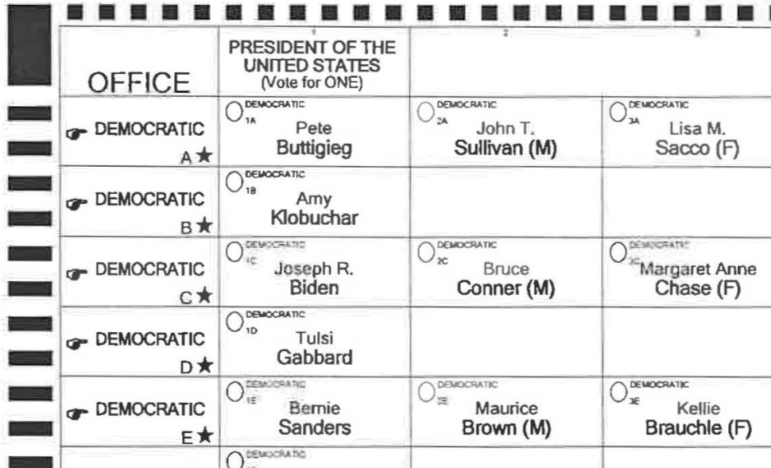
NYS BOE
A sample ballot presented by the state BOE to a federal judge.Disability rights groups sued the New York State Board of Elections (BOE) last Friday in a bid to make absentee voting accessible for voters with disabilities by the state’s June 23 primary.
There was a hearing on the lawsuit Friday morning. But the plaintiffs are already seeing some success outside of court, with the BOE passing a resolution on Wednesday to try to make PDF ballots available to some of those who request them for the primary.
The groups filed the lawsuit with the Southern District of New York (SDNY), alleging the BOE is violating the Americans with Disabilities Act by not providing an accessible absentee voting system.
They aim to compel the BOE to provide accessible absentee voting options to New Yorkers with disabilities, because the paper ballots the board currently uses are inaccessible to those with visual impairments and dexterity issues. This is so voters with disabilities can vote privately and independently without going to polling sites to use the accessible voting machines called ballot marking devices, which is a risk to their health amid the coronavirus pandemic.
The suit was filed by Disability Rights New York, the American Council of the Blind—New York (ACBNY), Center for Independence of the Disabled, New York (CIDNY) and the National Federation of the Blind of New York State. It also includes individual voters with disabilities: Rasheta Bunting, Karen Gourgey, Keith Gurgui, and Jose Hernandez. The plaintiffs are represented by Brown Goldstein & Levy LLP and Disability Rights Advocates.
The lawsuit comes on the heels of a Department of Justice (DOJ) complaint filed by some of the same advocacy groups in April requesting that absentee voting be made accessible to those with disabilities. Advocates said the lawsuit was necessary to push the BOE to make absentee voting accessible in New York by June 23 because the DOJ complaint won’t yield a result in time.
“The Department of Justice is taking a broad look at the election system in the state of New York, so it would not be completed by the June 23 primary,” said Clark Rachfal, the director of advocacy and public affairs at the American Council for the Blind. “So the plaintiffs of the case wanted a resolution that would impact the primary.”
The threat of voters contracting COVID-19 at polling sites led Governor Andrew Cuomo to push back the date of the primary to June and pass an executive order that allows all New York State residents to request an absentee ballot for the primary. The problem, advocates argue, is that those with visual impairments and dexterity issues can’t read or mark paper ballots independently and will likely need the help of another.
The plaintiffs argue there are accessible absentee voting methods available that the BOE can and should adopt in time for June. The first, is an absentee voting system provided to members of the military and those living overseas through the Uniformed and Overseas Citizens Absentee Voting Act (UOCAVA). In New York this law allows those covered by it to receive their ballots via email and print them to be marked and sent to the BOE.
“If they’re doing it for other people that shows that it can be done and should be done for voters with disabilities,” said Christina Brandt-Young, an attorney with Disability Rights Advocates who represents some of the plaintiffs.
The second option, Brandt-Young said, is Maryland’s accessible voting system, where they offer voters with disabilities an online tool that’s compatible with assistive technology, allowing them to read and mark their ballots independently. She added that Maryland has made this tool available for free and that other states are already using it.
In a declaration filed with the court this week, Thomas Connolly, the Board of Elections’ director of operations, argued the board was doing all it could to maximize accessibility given the quirks of New York’s election system, in which responsibility for administering elections is split between county boards and state authority.
“The changes to NYSBallot requested by the plaintiffs would be impossible before the June 2020 Primary,” Connolly wrote, noting that New York’s ballot has a unique layout, that county boards design the ballots and that because June 23 features state primaries, a presidential primary and, in one district, a Congressional special election, voters will each receive not one but two or three ballots.
“There are six voter registration vendors who would need to effectuate the programming changes to the counties’ systems,” Connolly noted. “Any changes would need to be tested to ensure they work and do not create unintended problems, and staff at each county board of elections would need to be trained.”
However, Connolly said the BOE was “working on an in-home ballot marking protocol for the June elections,” and cited the Maryland tool as a model that officials are exploring.
Gourgey, one of the individual plaintiffs, said making absentee voting accessible is imperative for her because she doesn’t want to risk contracting COVID-19 by going to the polls.
“if I want to vote independently, if we don’t have a solution here, I have to go to the polls,” Gourgey said. “So it’s really that simple.”
Gourgey also pointed out that in their efforts to increase absentee voting state officials have said no person should have to risk getting COVID-19 by going to the polls, and that there’s a blindspot for people with disabilities in those statements.
“So the conclusion I can’t help drawing is that that’s fine for everybody except people with disabilities who can’t privately and independently fill out a paper ballot,” Gourgey said.








